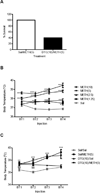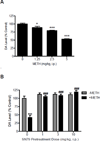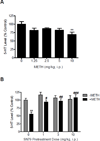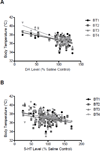Pharmacological evaluation of SN79, a sigma (σ) receptor ligand, against methamphetamine-induced neurotoxicity in vivo
- PMID: 22921523
- PMCID: PMC3748261
- DOI: 10.1016/j.euroneuro.2012.08.005
Pharmacological evaluation of SN79, a sigma (σ) receptor ligand, against methamphetamine-induced neurotoxicity in vivo
Abstract
Methamphetamine is a highly addictive psychostimulant drug of abuse, causing hyperthermia and neurotoxicity at high doses. Currently, there is no clinically proven pharmacotherapy to treat these effects of methamphetamine, necessitating identification of potential novel therapeutic targets. Earlier studies showed that methamphetamine binds to sigma (σ) receptors in the brain at physiologically relevant concentrations, where it "acts in part as an agonist." SN79 (6-acetyl-3-(4-(4-(4-florophenyl)piperazin-1-yl)butyl)benzo[d]oxazol-2(3H)-one) was synthesized as a putative σ receptor antagonist with nanomolar affinity and selectivity for σ receptors over 57 other binding sites. SN79 pretreatment afforded protection against methamphetamine-induced hyperthermia and striatal dopaminergic and serotonergic neurotoxicity in male, Swiss Webster mice (measured as depletions in striatal dopamine and serotonin levels, and reductions in striatal dopamine and serotonin transporter expression levels). In contrast, di-o-tolylguanidine (DTG), a well established σ receptor agonist, increased the lethal effects of methamphetamine, although it did not further exacerbate methamphetamine-induced hyperthermia. Together, the data implicate σ receptors in the direct modulation of some effects of methamphetamine such as lethality, while having a modulatory role which can mitigate other methamphetamine-induced effects such as hyperthermia and neurotoxicity.
Keywords: Dopamine; Hyperthermia; Methamphetamine; Neurotoxicity; Serotonin; Sigma receptors.
Copyright © 2012 Elsevier B.V. and ECNP. All rights reserved.
Figures








Similar articles
-
SN79, a sigma receptor antagonist, attenuates methamphetamine-induced astrogliosis through a blockade of OSMR/gp130 signaling and STAT3 phosphorylation.Exp Neurol. 2014 Apr;254:180-9. doi: 10.1016/j.expneurol.2014.01.020. Epub 2014 Feb 6. Exp Neurol. 2014. PMID: 24508558 Free PMC article.
-
CM156, a high affinity sigma ligand, attenuates the stimulant and neurotoxic effects of methamphetamine in mice.Neuropharmacology. 2011 Oct-Nov;61(5-6):992-1000. doi: 10.1016/j.neuropharm.2011.06.028. Epub 2011 Jul 7. Neuropharmacology. 2011. PMID: 21762711 Free PMC article.
-
Neuroprotective targets through which 6-acetyl-3-(4-(4-(4-fluorophenyl)piperazin-1-yl)butyl)benzo[d]oxazol-2(3H)-one (SN79), a sigma receptor ligand, mitigates the effects of methamphetamine in vitro.Eur J Pharmacol. 2014 Feb 5;724:193-203. doi: 10.1016/j.ejphar.2013.12.039. Epub 2013 Dec 28. Eur J Pharmacol. 2014. PMID: 24380829 Free PMC article.
-
Drugs of abuse-induced hyperthermia, blood-brain barrier dysfunction and neurotoxicity: neuroprotective effects of a new antioxidant compound H-290/51.Curr Pharm Des. 2007;13(18):1903-23. doi: 10.2174/138161207780858375. Curr Pharm Des. 2007. PMID: 17584116 Review.
-
Involvement of nicotinic receptors in methamphetamine- and MDMA-induced neurotoxicity: pharmacological implications.Int Rev Neurobiol. 2009;88:121-66. doi: 10.1016/S0074-7742(09)88006-9. Int Rev Neurobiol. 2009. PMID: 19897077 Review.
Cited by
-
Chlorophenylpiperazine analogues as high affinity dopamine transporter ligands.Bioorg Med Chem Lett. 2013 Dec 15;23(24):6920-6922. doi: 10.1016/j.bmcl.2013.09.038. Epub 2013 Oct 15. Bioorg Med Chem Lett. 2013. PMID: 24211020 Free PMC article.
-
Agmatine attenuates the discriminative stimulus and hyperthermic effects of methamphetamine in male rats.Behav Pharmacol. 2016 Sep;27(6):542-8. doi: 10.1097/FBP.0000000000000244. Behav Pharmacol. 2016. PMID: 27232669 Free PMC article.
-
Cannabidiol attenuates methamphetamine-induced conditioned place preference via the Sigma1R/AKT/GSK-3β/CREB signaling pathway in rats.Toxicol Res (Camb). 2020 May 9;9(3):202-211. doi: 10.1093/toxres/tfaa021. eCollection 2020 Jun. Toxicol Res (Camb). 2020. PMID: 32670551 Free PMC article.
-
SN79, a sigma receptor antagonist, attenuates methamphetamine-induced astrogliosis through a blockade of OSMR/gp130 signaling and STAT3 phosphorylation.Exp Neurol. 2014 Apr;254:180-9. doi: 10.1016/j.expneurol.2014.01.020. Epub 2014 Feb 6. Exp Neurol. 2014. PMID: 24508558 Free PMC article.
-
HIV-1, methamphetamine and astrocytes at neuroinflammatory Crossroads.Front Microbiol. 2015 Oct 27;6:1143. doi: 10.3389/fmicb.2015.01143. eCollection 2015. Front Microbiol. 2015. PMID: 26579077 Free PMC article. Review.
References
-
- Bowyer JF, Davis DL, Schmued L, Broening HW, Newport GD, Slikker W, Jr, Holson RR. Further studies on the role of hyperthermia in methamphetamine neurotoxicity. Journal of Pharmacology and Experimental Therapeutics. 1994;268:1571–1580. - PubMed
-
- Brunswick DJ, Benmansour S, Tejani-Butt SM, Hauptmann M. Effects of high-dose methamphetamine on monoamine uptake sites in rat brain measured by quantitative autoradiography. Synapse. 1992;11:287–293. - PubMed
-
- Callaghan RC, Cunningham JK, Sajeev G, Kish SJ. Incidence of Parkinson’s disease among hospital patients with methamphetamine-use disorders. Movement Disorders. 2010;25:2333–2339. - PubMed
-
- Cappon GD, Pu C, Vorhees CV. Time-course of methamphetamine-induced neurotoxicity in rat caudate-putamen after single-dose treatment. Brain Research. 2000;863:106–111. - PubMed
Publication types
MeSH terms
Substances
Grants and funding
LinkOut - more resources
Full Text Sources
Other Literature Sources
Medical

